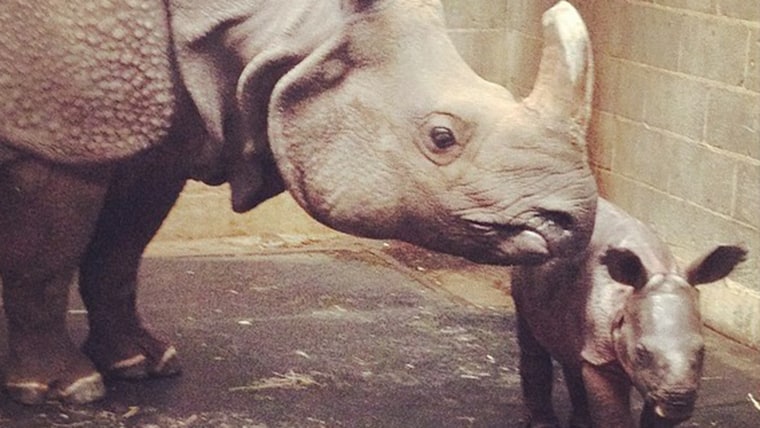Zookeepers’ excitement over the birth of a baby rhino isn’t just because she’s adorable. It’s a big deal because the endangered animal — named Monica — arrived a full decade after her father died.
Born at 3:30 p.m. June 5 at the Buffalo Zoo, the 144-pound female Indian rhino is the first offspring by a male rhino to die before becoming a father, according to a blog post on the zoo's website.
The birth via artificial insemination is being called a “major victory for endangered species around the world” as habitat loss, poaching, and population fragmentation threaten their extinction. Only 59 Indian rhinos are in captivity in North America, and just 2,500 remain in the wild.
“We are always thrilled to welcome a new baby to the Buffalo Zoo, but this birth is particularly exciting because the science involved is critical to saving endangered animals,” said Donna Fernandes, the president of the Buffalo Zoo.
Monica wouldn’t be here if it weren’t for the teamwork of zoo staffers in Cincinnati and Buffalo, 392 miles apart.
Before Monica’s father, Jimmy, died at the Cincinnati Zoo in 2004, his sperm was stored at negative-320 degrees in a cryogenic tank. Last year, that tank was transported to Buffalo, where a 17-year-old mama rhino named Tashi had delivered natural births in 2004 and 2008. Because Tashi’s mate at the Buffalo Zoo had died and that zoo’s new male Indian Rhino wasn’t old enough to be a father, time was of the essence, as large gaps between rhinoceros pregnancies can cause infertility.
In February 2013, the Cincinnati Zoo’s reproductive physiologist, Monica Stoops, collaborated with the Buffalo Zoo’s rhino keeper Joe Hauser and veterinarian Kurt Volle on a successful insemination process that led to the 15- to 16-month gestation period.
“Tashi and the calf are doing well, and are spending this time bonding indoors,” Hauser said in a statement.
There’s no timetable yet for the baby rhino’s public debut, which will have to wait several weeks while rhino keepers monitor her growth. In the meantime, staffers have snapped cute pictures of Monica resting with her mother, hanging out with Hauser and Stoops, and getting a closer look at the kind of cryogenic tank that led to her birth.
Hauser added that it’s no coincidence the Buffalo Zoo named the rhino Monica, as he cited the “countless hours” Monica Stoops dedicated to the cause.
“Without Dr. Stoops’ dedication to the species, and to the development of A.I. science, there is no doubt this calf would not be here today,” he said.
Follow TODAY.com contributor Chris Serico on Twitter.
